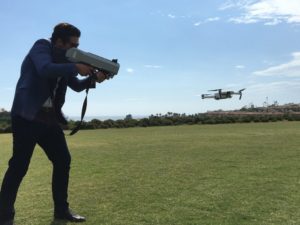
In California, the Oceanside Police Department has obtained an “anti-drone gun” to stop and land errant drones.
As drone use grows, many public agencies and companies are seeking anti-drone solutions to stop drones from flying over restricted or unsafe locations such as wildfire zones, nuclear power plants, prisons and airports.
Yorba Linda defense contractor IXI Technology donated its $30,000 Drone Killer to the OPD – a rifle-like device that uses RF frequency jamming and control disruption systems to force an unauthorized UAV to land where it hovers or return to home base where the violator can be tracked and arrested.
With a two-mile detection range, the device saw its first law-enforcement mission during the 2017 Rose Parade.
“The purpose is primarily for emergency situations,” Oceanside police Lt. Aaron Doyle told the LA Times. “It’s pretty much for a life-or-death situation, to save lives.” The department saw a need for a counter-drone device following drone aerial disruptions of fire-fighting efforts during devastating wildfires in San Diego County last year.
“Shutting down the operations for an hour can be critical to saving lives,” Doyle added. “We started looking for options in case it happened again.”
In March, the Queensland Police Service used a similar device during the XXI Commonwealth Games in Brisbane, Australia to neutralize a quadcopter breaching the aerial exclusion zone. The drone pilot was referred to Australia’s Civil Aviation Safety Authority for possible judicial action.
Drone detection devices also provide detection coverage for the Boston Marathon as well as the Davos Economic Forum in Switzerland.
In addition, the U.S. Navy in 2016 tested a virtual net it hopes can both detect and splash rogue drones before they become a clear and present danger. During an exercise, missile destroyers USS Lassen and USS Jason Dunham checked out an anti-drone capability sensor system in the Gulf of Mexico that tracked quadcopters launched by U.S. Air Force Academy cadets.
Jason is a longstanding contributor to DroneLife with an avid interest in all things tech. He focuses on anti-drone technologies and the public safety sector; police, fire, and search and rescue.
Beginning his career as a journalist in 1996, Jason has since written and edited thousands of engaging news articles, blog posts, press releases and online content.
Email Jason
TWITTER:@JasonPReagan
Subscribe to DroneLife here.